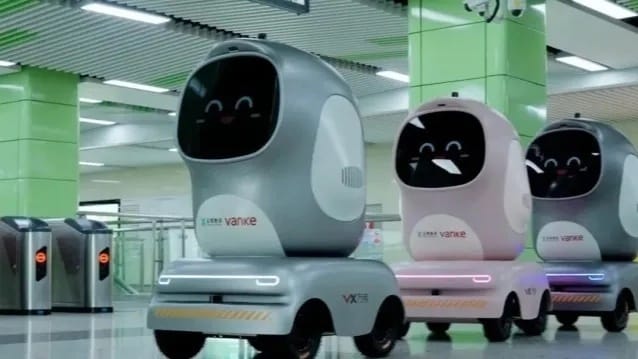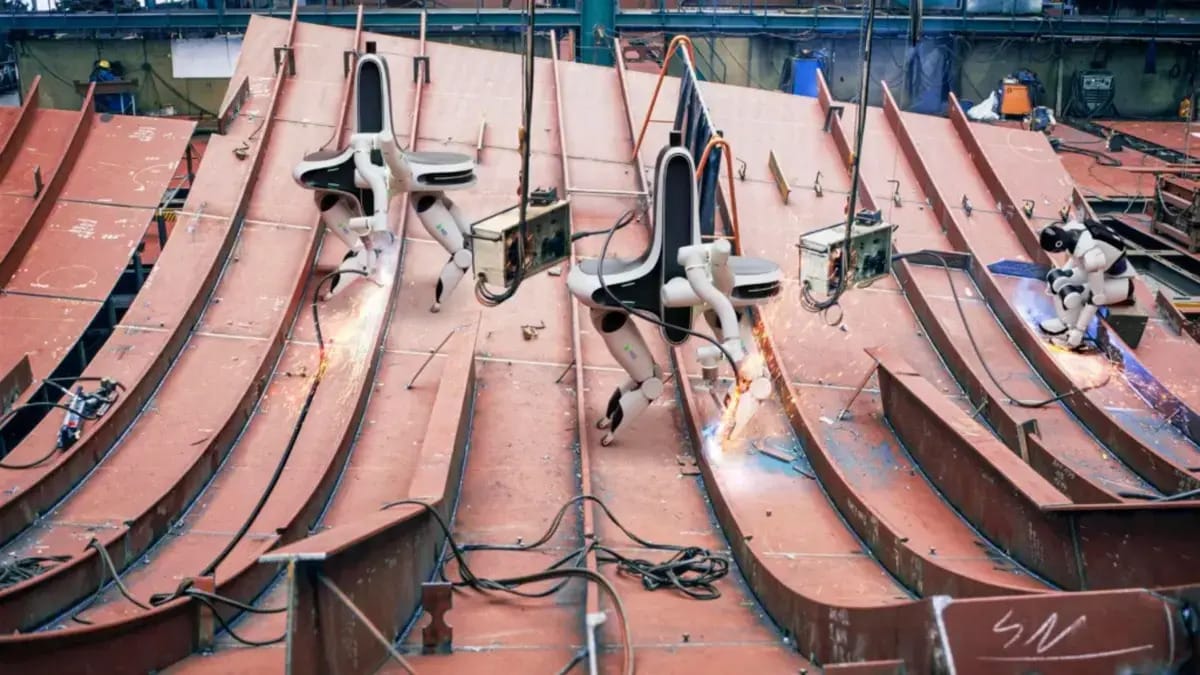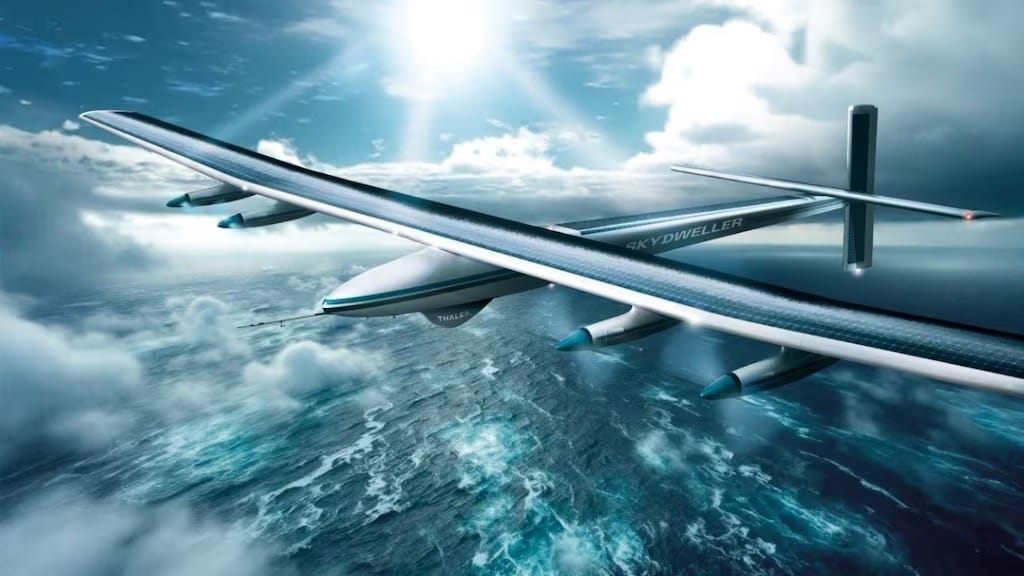- The Rundown Robotics
- Posts
- Delivery bots ride the subway
Delivery bots ride the subway
PLUS: Harvard's creepy wormbot swarm
Good morning, robotics enthusiasts. Shenzhen’s subway just got more crowded — with robots. Now, penguin-shaped delivery bots are cruising the city’s vast subway network, restocking snacks at 7-Elevens along the way.
Is this more than a convenience? Shenzhen is turning its subway into a robotic “middle mile” logistics network, offering a glimpse at the future of smart city supply chains.
In today’s robotics rundown:
China’s delivery robots ride the subway
Harvard creates creepy wormbot swarm
Neura’s humanoids to build ships
This jet-sized solar drone can fly for months
Quick hits on other robotics news
LATEST DEVELOPMENTS
CHINESE ROBOTICS

Image source: Vanke
The Rundown: In Shenzhen, a fleet of 41 penguin-shaped delivery bots now zips through the subway stations and boards trains autonomously, ferrying drinks and snacks to more than 100 7-Eleven locations.
The details:
The fleet of robots, each a meter tall with glowing LED “faces,” can navigate stations, elevators, and train carriages autonomously.
VX Logistics, a Vanke subsidiary, manages the operation, with the fleet serving over 100 7‑Eleven stores located within the city’s vast subway network.
Robots operate only during non‑peak hours to minimize congestion, replacing human couriers who otherwise need to park on the street and unload stock.
Equipped with panoramic lidar and smart chassis design, the bots reportedly avoid collisions, handle subway platform gaps, and maneuver crowded spaces.
Why it matters: Shenzhen’s “Embodied Intelligent Robot Action Plan” has flipped the script on city logistics — robots now ride the rails, delivering straight to subway shops and skipping the curbside chaos. In the race for robotic dominance, this is a serious flex: In Shenzhen, even the subway has joined the robot workforce.
HARVARD UNIVERSITY

Image source: Harry Tuazon/Georgia Institute of Technology
The Rundown: Harvard engineers just transformed the writhing, chaotic tangle of California blackworms into the blueprint for a new generation of robotic swarms — “roboworms” capable of autonomously entangling and moving as a unified collective.
The details:
The team found inspiration after studying the collective behavior of California blackworms, which naturally entangle themselves to move and survive.
The soft-bodied roboworms, about a foot long each, can physically latch onto and entwine with one another, forming dynamic multi-robot structures.
Each roboworm contains onboard sensors and simple rules for local interaction, enabling decentralized decision-making, with no central controller.
Their applications range from delicate search-and-rescue operations — where swarms could snake through rubble and debris — to planetary exploration.
Why it matters: The team aims to develop an untethered version that uses microfluidics to guide its action for full autonomy. Plus, the long-term goals of the project are to study the dynamics of group behaviors that emerge from entanglement, potentially creating supercharged AI systems that can scale walls and beyond.
NEURA ROBOTICS

Image source: Neura Robotics
The Rundown: Hyundai’s shipyards are getting a major robotic upgrade — not from its own robotics division or Boston Dynamics (which it owns), but from Germany’s Neura Robotics, whose humanoids will power next-generation robotic shipbuilders.
The details:
Hyundai signed a deal with Neura Robotics to develop four-legged bots and specialized humanoids for shipbuilding, leveraging its humanoid platform 4NE1.
HD Hyundai Samho will provide the hands-on testing environments at its shipbuilding facilities to get the robots up to speed.
The 4NE1 robots are designed for advanced manipulation, adaptability, and teamwork, making them well-suited for complex assembly on the shipyard floor.
Neura also recently announced a partnership with GFT Technology for its humanoids and raised $123M in Series B funding earlier this year.
Why it matters: This deal is a big shift in industrial automation, with one of the world’s top shipbuilders choosing cutting-edge, foreign-made humanoids over its own in-house solutions. The result of this team-up could push the arrival of truly intelligent, adaptable robots on some of the industry’s toughest front lines.
SKYDWELLER

Image source: Skydweller
The Rundown: U.S. startup Skydweller Aero joined forces with French defense giant Thales to develop a solar-powered autonomous drone that can stay aloft for months and has a 236-foot wide wingspan, even bigger than a Boeing 747.
The details:
Dubbed Skydweller, the drone’s surface is covered with 17K high-efficiency solar cells, making it capable of flying for months without refueling.
It can cruise at high altitudes, making it ideal for persistent intelligence, surveillance, and reconnaissance (ISR) missions.
Onboard AI analyzes massive data streams mid-flight, autonomously filtering information and deciding what is to be transmitted to command centers.
Skydweller is also featherweight compared to a jumbo jet, topping out at just 2.5 metric tons, making it 160 times lighter than a fully loaded Boeing 747.
Why it matters: This giant AI-powered drone could patrol the world’s oceans nonstop — silently gathering data day and night, streaming real-time maritime intel, and never burning a drop of fuel or needing to land. If Skydweller hits its targeted milestones for endurance flight, it could rewrite the playbook for airborne surveillance.
QUICK HITS
📰 Everything else in robotics today
Hugging Face said that it hit $1M in sales for its Reachy Mini desktop robot just five days after opening up orders.
Ex-Waymo engineers launched Bedrock Robotics with $80M in funding to retrofit existing construction equipment with 24/7 autonomous systems.
Gartner predicts that 1 in 20 supply chain managers will manage robots, not humans, by 2030.
Baidu and Uber plan to place thousands of Baidu’s Apollo Go autonomous vehicles on the Uber platform in markets outside the U.S. and mainland China.
China’s robot wolves have reportedly been deployed in a human-drone drill for the Chinese People’s Liberation Army.
“Rizzbot,” a Unitree humanoid, has been seen wearing a cowboy hat and Pride flags while walking through traffic and engaging pedestrians in West Hollywood, LA.
Tesla sharply expanded its geofenced operating area for its invite-only Robotaxi pilot in Austin, less than a month after it debuted the service.
MIT researchers developed a deep-learning control system that teaches soft, bio-inspired robots to move and follow commands from just a single image.
Chinese flying car company XPeng Aeroht nabbed $250M in Series B funding to accelerate its Land Aircraft Carrier modular flying car.
COMMUNITY
Join our next workshop this Friday, July 18th, at 4 PM EST with Dr. Alvaro Cintas, The Rundown’s AI professor. By the end of the workshop, you'll be able to use Perplexity Comet (and other alternatives) to automate your browsing experience.
RSVP here. Not a member? Join The Rundown University on a 14-day free trial.
That's it for today!Before you go we'd love to know what you thought of today's newsletter to help us improve The Rundown experience for you. |
See you soon,
Rowan, Jennifer, and Joey—The Rundown’s editorial team

